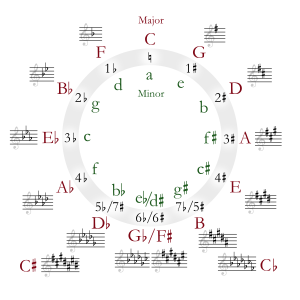B-flat minor

| ||
| Relative key | D♭ major | |
|---|---|---|
| Parallel key | B♭ major | |
| Dominant key | ||
| Subdominant | ||
| Notes in this scale | ||
| B♭, C, D♭, E♭, F, G♭, A♭, B♭ | ||
B♭ minor or B-flat minor is a minor scale based on B♭. Its key signature has five flats. It has the pitches of B♭ , C, D♭, E♭, F, G♭, A♭, and B♭.
Its relative major is D-flat major, and its parallel major is B-flat major. Its enharmonic equivalent is A-sharp minor.
B-flat minor is often seen as a "dark" key.[1] Tchaikovsky said that the oboe solo in B-flat minor in the second movement of his Symphony No. 4 was "the feeling that you get when you are all alone".
The old valveless horn could not play easily in B-flat minor. In fact, the only example found in 18th century music is a modulation in the first minuet of Franz Krommer's Concertino in D major, Opus 80.[2]
In classical music
- Frédéric Chopin's Piano Sonata No. 2, Nocturne Op. 9 No. 1, and Scherzo No. 2
- Sergei Rachmaninoff's Piano Sonata No. 2
- Dmitri Shostakovich's Symphony No. 13
- Peter Tchaikovsky's Piano Concerto No. 1
- Peter Tchaikovsky's Marche Slave
- Sir William Walton's Symphony No. 1
In popular music
- "Part-Time Lover"[3] – Stevie Wonder
- "Cannonball (Damien Rice song)"[4] - Damien Rice
- All eight songs on The Raveonettes' Whip It On album are in the key of B-flat minor. Sune Rose Wagner said it was because "Shostakovich's symphony no. 13 was in B flat minor".[5]
 |
| ||||||||||||||||||||||||||||||||||||||||||||||||||||||
| The table shows the number of sharps or flats in each scale. Minor scales are written in lower case. | |||||||||||||||||||||||||||||||||||||||||||||||||||||||
References
- ↑ Wilfred Mellers, "Round and About in Górecki's Symphony No. 3" Tempo 168 3 (1989): 23
- ↑ J. Murray Barbour, Trumpets, Horns, and Music (1964), p. 163
- ↑ "Stevie Wonder – Classic Hits". Archived from the original on 2004-08-15. Retrieved 2008-02-07.
- ↑ "Karaoke Page". Retrieved 2010-03-03.
- ↑ "10 Questions with Sune Rose Wagner". Retrieved 2008-02-07.
Wikimedia Commons has media related to B-flat minor.